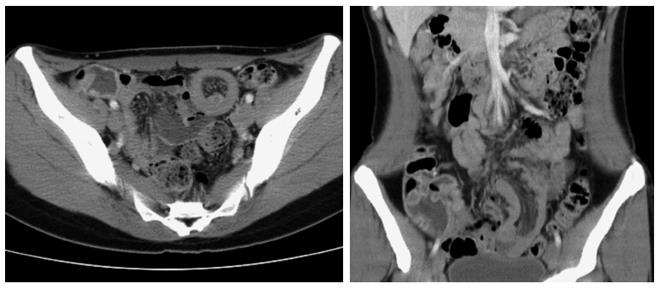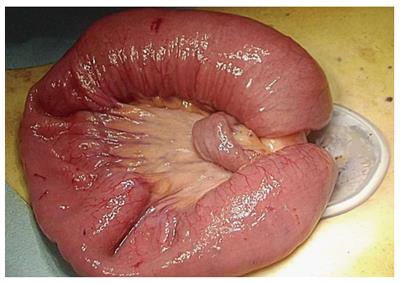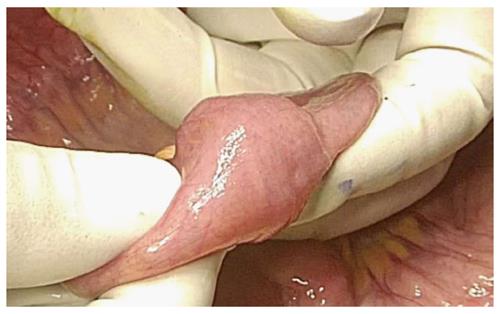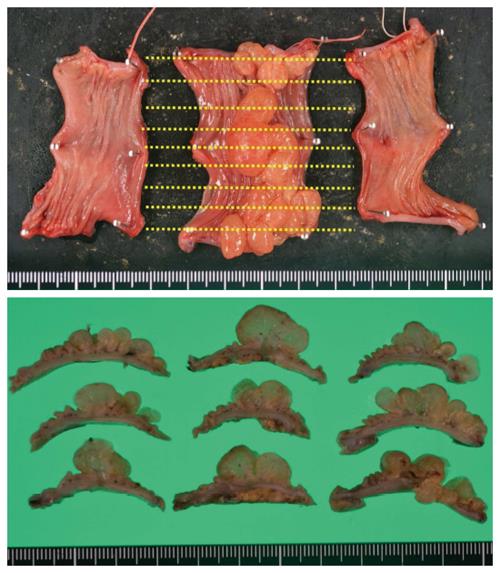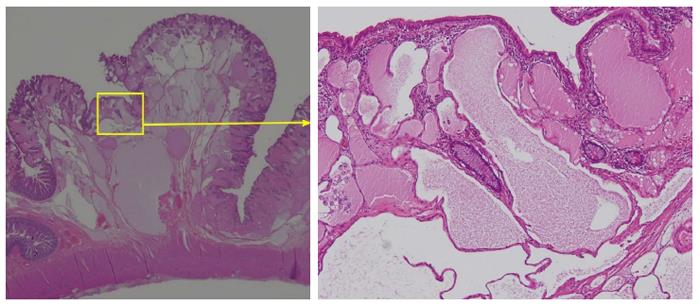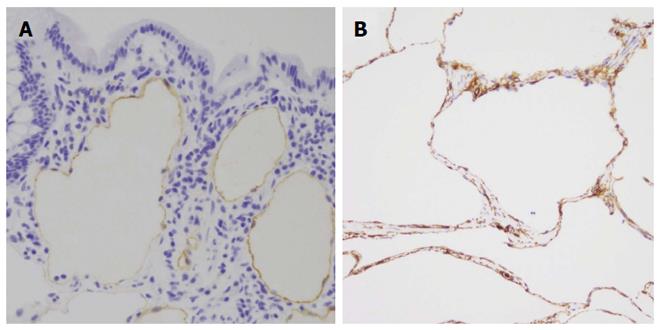Published online Jan 7, 2017. doi: 10.3748/wjg.v23.i1.167
Peer-review started: July 30, 2016
First decision: September 28, 2016
Revised: October 7, 2016
Accepted: October 30, 2016
Article in press: October 31, 2016
Published online: January 7, 2017
Processing time: 161 Days and 18.7 Hours
Intraabdominal lymphangiomas are uncommon; additionally, those affecting the gastrointestinal tract are rare and account for less than 1% of cases. Intussusception caused by a cystic lymphangioma of the small bowel is extremely rare. The patient was a 20-year-old woman who visited our emergency room with a complaint of abdominal pain. A computed tomography image revealed ileo-ileal intussusception with a leading hypovascular mass measuring 1 cm in a diameter. Single-incision laparoscopic-assisted ileal resection was performed. The surgical specimen consisted of a soft polycystic mass. Macroscopically, a pedunculated polyp with a convolutional pattern was found. Microscopically, the inner surfaces of the cysts were covered with a single layer of endothelial cells. On immunohistochemical examination, the endothelial cells were partially positive for D2-40 and CD34. Smooth muscle cells were also found around the cysts. The lesion was diagnosed as a cystic lymphangioma. Dozens of cases of small bowel lymphangiomas have previously been reported. Of these, cases with intussusception were very rare. This is the first case of small bowel intussusception due to lymphangioma treated by single-incision laparoscopic-assisted surgery.
Core tip: We observed an extremely rare case of small bowel intussusception caused by cystic lymphangioma. Dozens of lymphangiomas of the small bowel have previously been reported. Of these, few cases with intussusception have been reported. In the present case, single-incision laparoscopic-assisted surgery was useful for treating the telescoped lesion. To our knowledge, no cases of small bowel intussusception due to lymphangioma have been treated by laparoscopic surgery.
- Citation: Kohga A, Kawabe A, Hasegawa Y, Yajima K, Okumura T, Yamashita K, Isogaki J, Suzuki K, Komiyama A. Ileo-ileal intussusception caused by lymphangioma of the small bowel treated by single-incision laparoscopic-assisted ileal resection. World J Gastroenterol 2017; 23(1): 167-172
- URL: https://www.wjgnet.com/1007-9327/full/v23/i1/167.htm
- DOI: https://dx.doi.org/10.3748/wjg.v23.i1.167
Compared to the rate observed in children, intussusception in adults is uncommon. Ninety-five percent of cases of intussusception occur in children[1,2]. Small bowel neoplasms such as metastatic tumours, adenocarcinoma, gastrointestinal tumours, lymphoma, carcinoid tumours and other tumours including benign lesions may induce intussusception in adults[3,4]. Lymphangioma is a congenital lymphatic system malformation[5], and a small proportion of lymphangiomas occur in the gastrointestinal tract[6]. Intussusception caused by lymphangioma of the small bowel is extremely rare[7]. Here, we report the case of a young woman with intussusception caused by lymphangioma of the small bowel who was treated by single-incision laparoscopic-assisted ileal resection.
The patient was a 20-year-old woman who visited our emergency room due to a complaint of abdominal pain. A physical examination revealed mild tenderness in the upper right abdomen without peritoneal irritation signs. The patient had no past history of co-morbid medical or surgical illness. Laboratory data showed slight leukocytosis (WBC 108 × 102/μL) with a moderately elevated C-reactive protein level (CRP, 4.19 mg/dL).
Ultrasonography of the upper right abdomen indicated no significant findings. A computed tomography (CT) image revealed ileo-ileal intussusception in the lower abdomen with a leading hypovascular mass measuring 1 cm in a diameter (Figure 1). The preoperative diagnosis was intussusception of the small bowel due to inverted Meckel’s diverticulum or a benign tumour.
Single-incision laparoscopic-assisted ileal resection was immediately performed. A single incision measuring approximately 2.5 cm long was performed at the umbilicus, and two 5-mm trocars were placed in the incision using a disposable protractor, one for camera port and the other for the forceps. An ileo-ileal intussusception was found via laparoscopic inspection. The involved segment of the small bowel was removed through the incision using forceps and hands (Figure 2). The intussusception was released by applying the Hutchinson manoeuvre. We then observed that the soft mass was the leading point of the intussusception (Figure 3). Ileal resection was performed, and the mass was resected.
The surgical specimen consisted of a soft polycystic mass. Macroscopically, a pedunculated polyp with a convolutional pattern was found. A polycystic appearance was noted on the cut surface. We performed additional resection of the ileum on both the oral and anal side due to an insufficient margin. The cut sections of the specimen revealed multiple cystic lesions located mainly in the mucosal to submucosal layer (Figure 4). Microscopically, the inner surfaces of the cysts were covered with a single layer of endothelial cells. No blood cells were found in the cysts (Figure 5). On immunohistochemical examination, the endothelial cells were partially positive for D2-40 and CD34. Smooth muscle cells were also found around the cysts (Figure 6). The lesion was diagnosed as cystic lymphangioma. The postoperative course was uneventful, and the patient was discharged on the 7th postoperative day without postoperative complications.
In the present report, we present an extremely rare case of small bowel intussusception caused by cystic lymphangioma of the ileum. Cystic lymphangioma was first described by Radenbacker[8]. Lymphangioma is a congenital disease and occurs more frequently in the head, neck and axilla; however, intraabdominal lymphangiomas are uncommon, and those that affect the gastrointestinal tract are rare and account for less than 1% of cases[5,9,10].
Generally, lymphangiomas primarily occur in children. However, reported cases of small bowel lymphangiomas exhibit a wide age range. Morris-Stiff et al[11] reported that a Japanese/Taiwanese predisposition to small bowel lymphangiomas may exist. According to the Japanese literature, Kurokawa reviewed 40 patients with small bowel lymphangiomas and suggested a slight male predominance[12].
Pathologically, lymphangiomas are divided into three groups: simple capillary lymphangioma, cavernous lymphangioma, and cystic lymphangioma[7,13,14]. Of these, the present case was diagnosed as a cystic lymphangioma consisting of a large macroscopic lymphatic space with investitures of collagen and smooth muscle[15].
Small bowel lymphangiomas usually present no symptoms but can sometimes cause melena, abdominal pain, intussusception, ileus and protein-losing gastroenteropathy[5,16]. Although CT images are useful for the diagnosis of intussusception, radiologic studies are not a conclusive test for diagnosis[1,7].
In the present case, the presence of a mild tenderness in the upper right abdomen interfered with the diagnosis of ileo-ileal intussusception by ultrasonography.
Dozens of lymphangiomas of the small bowel have previously been reported[17-20]. Of these, a few cases have been reported to result in intussusception[7,21]. In the Japanese literature, Kurokawa reported 7 cases of small bowel lymphangioma with intussusception[12].
Surgical resection is the standard treatment. Relapses may occur if vesicles or part of the tumour remain unresectable[5,22-24]. Therefore, it seems plausible that additional resection should be performed if the surgical margin is not sufficient.
Generally, single-incision laparoscopic-assisted surgery (SILS) is considered a less invasive and more aesthetic method than conventional multi-port laparoscopic surgery[25]. However, SILS currently has limitations for its indication[26,27]. With regard to small intestine resection, Nickerson et al[28] suggested that SILS is effective and feasible for resection of small bowel tumours. Additionally, some authors have reported cases of small bowel intussusception treated by SILS[25,29]. In the present case, we removed the telescoped segment through the umbilical incision; then, reduction was performed under direct vision. We consider SILS a feasible procedure for small bowel intussusception only if the intussusception is thought to be caused by a benign lesion and the telescoped segment is sufficiently short to pass the umbilical incision. To our knowledge, no cases of small bowel intussusception due to lymphangioma have been treated by laparoscopic surgery or SILS.
Recently, several cases of small bowel lymphangioma causing intestinal bleeding have been treated by endoscopic polypectomy using double-balloon enteroscopy[16,30]. Endoscopic polypectomy might be a useful method to treat small bowel lymphangioma without intussusception.
In conclusion, we reported a rare case of small bowel intussusception caused by a cystic lymphangioma. SILS was useful for the small bowel intussusception caused by a benign lesion in the present case.
A 20-year-old woman presented with an abdominal pain. Mild tenderness in upper right abdomen without peritoneal irritation signs was found.
Intussusception of small bowel.
Intussusception of small bowel due to inverted Meckel’s diverticulum or a benign tumor.
Laboratory data showed slight leukocytosis (WBC, 108 × 102/μL) with moderately elevated C-reavtive protein (CRP, 4.19 mg/dL), suggesting presence of inflammation.
Ileo-ileal intussusception in the lower abdomen with the leading point of hypovascular mass measuring 1 cm in a diameter.
Cystic lymphangioma of ileum.
Surgical resection.
Previously, dozens of lymphangioma of the small bowel had been reported. Of these, a few cases have been reported to set up intussusception.
Lymphangiomas is congenital disease and occur more frequently in the head, neck and axilla, however, intraabdominal lymphangiomas are uncommon. Pathologically, Lymphangiomas are divided into three groups: simple capillary lymphangioma, cavernous lymphangioma, and cystic lymphangioma.
The authors experienced a rare case of small bowel intussusception caused by cystic lymphangioma. single-incision laparoscopic-assisted surgery was useful for the small bowel intussusception caused by benign lesion as the present case.
The authors offered an interesting case with well treatment. Indeed, it is rare. The authors described a patient got ileo-ileal intussusception caused by lymphangioma of small bowel, and treated by single-incision lapascopic-assisted ileal resection.
Manuscript source: Unsolicited manuscript
Specialty type: Gastroenterology and hepatology
Country of origin: Japan
Peer-review report classification
Grade A (Excellent): 0
Grade B (Very good): 0
Grade C (Good): C, C
Grade D (Fair): 0
Grade E (Poor): 0
P- Reviewer: Lakatos PL, Lee HC S- Editor: Gong ZM L- Editor: A E- Editor: Wang CH
| 1. | Begos DG, Sandor A, Modlin IM. The diagnosis and management of adult intussusception. Am J Surg. 1997;173:88-94. [RCA] [PubMed] [DOI] [Full Text] [Cited by in Crossref: 365] [Cited by in RCA: 386] [Article Influence: 13.8] [Reference Citation Analysis (0)] |
| 2. | Marinis A, Yiallourou A, Samanides L, Dafnios N, Anastasopoulos G, Vassiliou I, Theodosopoulos T. Intussusception of the bowel in adults: a review. World J Gastroenterol. 2009;15:407-411. [RCA] [PubMed] [DOI] [Full Text] [Full Text (PDF)] [Cited by in CrossRef: 428] [Cited by in RCA: 531] [Article Influence: 33.2] [Reference Citation Analysis (7)] |
| 3. | Hodin RA, Matthews JB. Small intestine. Surgery: Basic Science and Clinical Evidence. New York: Springer 2008; 963-990. |
| 4. | Coco C, Rizzo G, Manno A, Mattana C, Verbo A. Surgical treatment of small bowel neoplasms. Eur Rev Med Pharmacol Sci. 2010;14:327-333. [PubMed] |
| 5. | Uncu H, Erdem E, Kuterdem E. Lymphangiomas of the ileum: a report of two cases and a review of the literature. Surg Today. 1997;27:542-545. [RCA] [PubMed] [DOI] [Full Text] [Cited by in Crossref: 4] [Cited by in RCA: 5] [Article Influence: 0.2] [Reference Citation Analysis (0)] |
| 6. | Good CA. Tumors of the small intestine. Am J Roentgenol Radium Ther Nucl Med. 1963;89:685-705. [PubMed] |
| 7. | Limaiem F, Khalfallah T, Marsaoui L, Bouraoui S, Lahmar A, Mzabi S. Jejunal lymphangioma: an unusual cause of intussusception in an adult patient. Pathologica. 2015;107:19-21. [PubMed] |
| 8. | Daniel S, Lazarevic B, Attia A. Lymphangioma of the mesentery of the jejunum: report of a case and a brief review of the literature. Am J Gastroenterol. 1983;78:726-729. [PubMed] |
| 10. | Wan YL, Lee TY, Hung CF, Ng KK. Ultrasound and CT findings of a cecal lymphangioma presenting with intussusception. Eur J Radiol. 1998;27:77-79. [RCA] [PubMed] [DOI] [Full Text] [Cited by in Crossref: 21] [Cited by in RCA: 20] [Article Influence: 0.7] [Reference Citation Analysis (0)] |
| 11. | Morris-Stiff G, Falk GA, El-Hayek K, Vargo J, Bronner M, Vogt DP. Jejunal cavernous lymphangioma. BMJ Case Rep. 2011;2011. [RCA] [PubMed] [DOI] [Full Text] [Cited by in Crossref: 7] [Cited by in RCA: 10] [Article Influence: 0.7] [Reference Citation Analysis (0)] |
| 12. | Kurokawa T, Kanai M, Kaneko Y, Takahashi , Motohara T. A case of Lymphangioma of the Jejunum Presenting with Intussusception. Jpn J Gastroenterol Surg. 2011;44:1597-1603. [RCA] [DOI] [Full Text] [Cited by in Crossref: 2] [Cited by in RCA: 2] [Article Influence: 0.1] [Reference Citation Analysis (0)] |
| 13. | Wegener G. Ueber. lymphangiome. Arch Klin Chir. 1877;20:641-707. |
| 14. | Chen CW, Hsu SD, Lin CH, Cheng MF, Yu JC. Cystic lymphangioma of the jejunal mesentery in an adult: a case report. World J Gastroenterol. 2005;11:5084-5086. [RCA] [PubMed] [DOI] [Full Text] [Full Text (PDF)] [Cited by in CrossRef: 36] [Cited by in RCA: 52] [Article Influence: 2.6] [Reference Citation Analysis (0)] |
| 15. | Rieker RJ, Quentmeier A, Weiss C, Kretzschmar U, Amann K, Mechtersheimer G, Bläker H, Herwart OF. Cystic lymphangioma of the small-bowel mesentery: case report and a review of the literature. Pathol Oncol Res. 2000;6:146-148. [RCA] [PubMed] [DOI] [Full Text] [Cited by in Crossref: 41] [Cited by in RCA: 53] [Article Influence: 2.1] [Reference Citation Analysis (0)] |
| 16. | Kida A, Matsuda K, Hirai S, Shimatani A, Horita Y, Hiramatsu K, Matsuda M, Ogino H, Ishizawa S, Noda Y. A pedunculated polyp-shaped small-bowel lymphangioma causing gastrointestinal bleeding and treated by double-balloon enteroscopy. World J Gastroenterol. 2012;18:4798-4800. [RCA] [PubMed] [DOI] [Full Text] [Full Text (PDF)] [Cited by in CrossRef: 15] [Cited by in RCA: 14] [Article Influence: 1.1] [Reference Citation Analysis (0)] |
| 17. | Childs WA, Rosenstiel HC. Lymphangioma of the small intestine. Surgery. 1955;37:650-652. [PubMed] |
| 18. | Barquist ES, Apple SK, Jensen DM, Ashley SW. Jejunal lymphangioma. An unusual cause of chronic gastrointestinal bleeding. Dig Dis Sci. 1997;42:1179-1183. [RCA] [PubMed] [DOI] [Full Text] [Cited by in Crossref: 14] [Cited by in RCA: 11] [Article Influence: 0.4] [Reference Citation Analysis (0)] |
| 19. | Kunimura T, Inagaki T, Hayashi R, Katou H, Iwaku K, Morohoshi T. A case of multiple colonic lymphangiomas causing intussusception. J Gastroenterol. 2005;40:316-318. [RCA] [PubMed] [DOI] [Full Text] [Cited by in Crossref: 3] [Cited by in RCA: 6] [Article Influence: 0.3] [Reference Citation Analysis (0)] |
| 20. | Bucciero F, Marsico M, Galli A, Tarocchi M. Small bowel lymphangioma: A rare case of intestinal bleeding. Dig Liver Dis. 2015;47:815. [RCA] [PubMed] [DOI] [Full Text] [Cited by in Crossref: 6] [Cited by in RCA: 7] [Article Influence: 0.7] [Reference Citation Analysis (0)] |
| 21. | Oshita M, Okazaki T, Yamataka A, Kusafuka J, Lane GJ, Matsumoto T, Miyano T. Jejuno-jejunal intussusception secondary to submucosal lymphangioma in a child. Pediatr Surg Int. 2005;21:1001-1003. [RCA] [PubMed] [DOI] [Full Text] [Cited by in Crossref: 2] [Cited by in RCA: 3] [Article Influence: 0.2] [Reference Citation Analysis (0)] |
| 22. | Raszkowski HJ, Rehbock DJ, Cooper FG. Mesenteric and retroperitoneal lymphangioma. Am J Surg. 1959;97:363-367. [RCA] [PubMed] [DOI] [Full Text] [Cited by in Crossref: 13] [Cited by in RCA: 14] [Article Influence: 0.6] [Reference Citation Analysis (0)] |
| 23. | Chen CF, Chuang CH, Lu CY, Hu C, Kuo TL, Hsieh JS. Adult intussusception secondary to lymphangioma of the cecum: a case report. Kaohsiung J Med Sci. 2009;25:347-352. [RCA] [PubMed] [DOI] [Full Text] [Full Text (PDF)] [Cited by in Crossref: 10] [Cited by in RCA: 8] [Article Influence: 0.5] [Reference Citation Analysis (0)] |
| 24. | Fernandes BF, Moraes ÉN, de Oliveira FR, Benevides GN, Felipe-Silva A, Ferreira CR, de Alcântara PS, Tokeshi F, Martinês JA, Ferronato ÂE. Subserous lymphangioma of the sigmoid colon: an uncommon cause of acute abdomen in pediatric patients. Autops Case Rep. 2015;5:65-70. [RCA] [PubMed] [DOI] [Full Text] [Full Text (PDF)] [Cited by in Crossref: 4] [Cited by in RCA: 4] [Article Influence: 0.4] [Reference Citation Analysis (0)] |
| 25. | Yu H, Wu S, Zhu R, Yu X. Single-incision laparoscopic-assisted ileal resection for adult intussusception. J Minim Access Surg. 2016;12:182-185. [RCA] [PubMed] [DOI] [Full Text] [Cited by in Crossref: 2] [Cited by in RCA: 3] [Article Influence: 0.3] [Reference Citation Analysis (0)] |
| 26. | Kim SG, Moon JI, Choi IS, Lee SE, Sung NS, Chun KW, Lee HY, Yoon DS, Choi WJ. Risk factors for conversion to conventional laparoscopic cholecystectomy in single incision laparoscopic cholecystectomy. Ann Surg Treat Res. 2016;90:303-308. [RCA] [PubMed] [DOI] [Full Text] [Full Text (PDF)] [Cited by in Crossref: 10] [Cited by in RCA: 10] [Article Influence: 1.1] [Reference Citation Analysis (0)] |
| 27. | Trastulli S, Cirocchi R, Desiderio J, Guarino S, Santoro A, Parisi A, Noya G, Boselli C. Systematic review and meta-analysis of randomized clinical trials comparing single-incision versus conventional laparoscopic cholecystectomy. Br J Surg. 2013;100:191-208. [RCA] [PubMed] [DOI] [Full Text] [Cited by in Crossref: 144] [Cited by in RCA: 132] [Article Influence: 11.0] [Reference Citation Analysis (0)] |
| 28. | Nickerson TP, Aho JM, Bingener J. Single-incision laparoscopic resection of small bowel tumours: Making it easier for patient and surgeon. J Minim Access Surg. 2016;12:235-239. [RCA] [PubMed] [DOI] [Full Text] [Cited by in Crossref: 3] [Cited by in RCA: 4] [Article Influence: 0.4] [Reference Citation Analysis (0)] |
| 29. | Pitiakoudis M, Romanidis K, Giatromanolaki A, Courcoutsakis N, Nagorni EA, Foutzitzi S, Tsaroucha A, Zezos P, Kouklakis G. Single-incision assisted laparoscopic surgery (SILS) in the treatment of an intussusception induced by a solitary hamartomatous polyp: a case report and review of the literature. J Med Case Rep. 2015;9:125. [RCA] [PubMed] [DOI] [Full Text] [Full Text (PDF)] [Cited by in Crossref: 8] [Cited by in RCA: 10] [Article Influence: 1.0] [Reference Citation Analysis (0)] |
| 30. | Li F, Osuoha C, Leighton JA, Harrison ME. Double-balloon enteroscopy in the diagnosis and treatment of hemorrhage from small-bowel lymphangioma: a case report. Gastrointest Endosc. 2009;70:189-190. [RCA] [PubMed] [DOI] [Full Text] [Cited by in Crossref: 8] [Cited by in RCA: 10] [Article Influence: 0.6] [Reference Citation Analysis (0)] |













